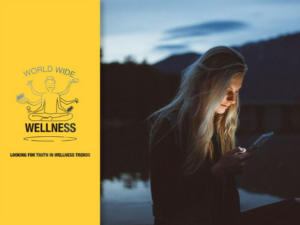Many of us have indulged in a glass of wine (or perhaps a few) at social events.
It might be our drink of choice to accompany a meal or unwind after a long day at work.
When it comes to drinking alcohol, wine may seem like the safest choice. After all, most of us have likely heard that a glass a day can even improve our health.
But is this really the case?
THE RISE OF ‘WINEFLUENCERS’
Wine is widely consumed in Western culture.
It’s estimated that every Australian 15 years and older consumes the equivalent of 38 bottles of wine a year.
Social media has helped promote wine consumption.
Wine influencers have become increasingly popular, particularly among younger generations.

Credit: Diana Dunaeva CC0
These influencers promote brands and influence consumers’ decisions. They also help audiences learn about wine.
With the rise of winefluencers and access to varied sources of information about wine, consumers constantly receive mixed messages about its consumption.
This can be overwhelming. Luckily, scientific research has some answers.
A GLASS A DAY KEEPS THE DOCTOR AWAY?

Credit: Polina via Pexels CC0
In the 1970s, studies showed people who consumed one to two drinks per day appeared to have a lower risk of heart disease – and even lived longer than those who didn’t drink.
“Early research found that moderate levels of wine consumption had a J-shaped curve effect,” Helena Conibear, co-director of the International Scientific Forum on Alcohol Research, told the BBC.
“Small, regular amounts of wine seem to lead to longer life, better health and less cognitive decline.”
Then came the French paradox in the 1980s, showing low rates of heart disease among the French despite their frequent consumption of saturated fats and dietary cholesterol.
What is it about wine that explains trends like the J curve or the French paradox?
WINE NOT?
Wine (especially red) contains polyphenols – chemical compounds that help to keep us healthy.
Resveratrol is a polyphenol and acts like an antioxidant. This means it neutralises free radicals – unstable molecules that can harm our cells and DNA.
Resveratrol also has anti-inflammatory effects and is believed to reduce hypertension and heart disease.

Credit: Asawin CC0 1.0
A large body of research reiterates that small doses of wine can be beneficial.
But some researchers believe the health benefits attributed to wine have been overestimated.
There are still questions around the dosages of resveratrol. After all, it may not be as simple as consuming one or two glasses of wine to gain its benefits.
“There’s controversy around the level of dose you can absorb from a glass of wine and its bioavailability, which is the body’s ability to absorb it and do us good,” says Helena.
Even the French paradox raises questions, because it doesn’t necessarily reflect the reality of other countries.
The J curve has also been questioned.
J OR NAY?
Professor Tanya Chikritzhs leads the Alcohol Policy Research team at the National Drug Research Institute at Curtin University.
She has studied the J curve for more than 15 years.
Tanya believes the J curve might be flawed and is an inaccurate reflection of alcohol consumption versus disease or death rates.
“All the studies are observational, which means they classify people into different groups (based on their drinking history) and compare health outcomes,” Tanya told ABC News.
She said the J curve “makes the non-drinker group look as if they’re in bad health because they don’t drink”.
Alcohol itself is not necessarily the cause (or absence) of cardiovascular disease but rather the differences between drinkers and non-drinkers.
“Studies supporting the J curve continue to be published, but they suggest drinking may not give us as much of an edge as we’d hoped,” says Tanya.
POUR DECISIONS
But it’s not an entirely rosé picture.
All alcoholic drinks, including wine, have a negative impact on our health.
In Australia, a standard drink is 10g (or 12.5mL) of alcohol.
The National Health and Medical Research Council guidelines suggest no more than four standard drinks on a single occasion and no more than 10 standard drinks per week.
Even if this is the recommendation, what were considered the ‘safe’ levels under the J curve paradigm are now considered closer to half a standard drink, according to Tanya.

Credit: Dalila Dalprat CC0
Alcohol (including wine) consumption has been linked to more than 40 medical conditions.
They include stroke, cirrhosis, fetal alcohol spectrum disorder and cancer. In fact, alcohol is an often ignored carcinogen.
Alcohol consumption has also been linked to depression and an increased risk of suicide.
Even if you drink in moderation, it’s important to keep the health risks in mind.
And with non-alcoholic wines now readily available, consumers can still enjoy a glass or two – with a twist.









